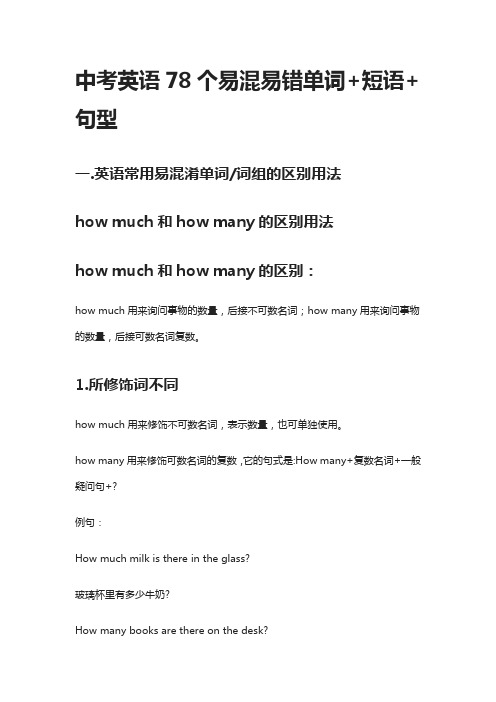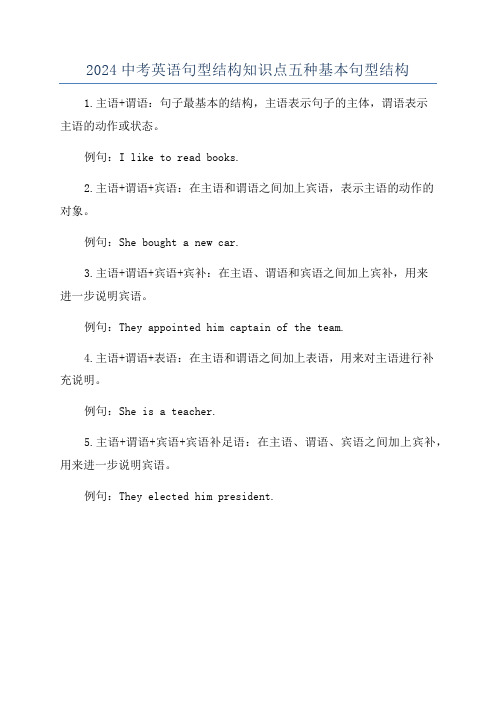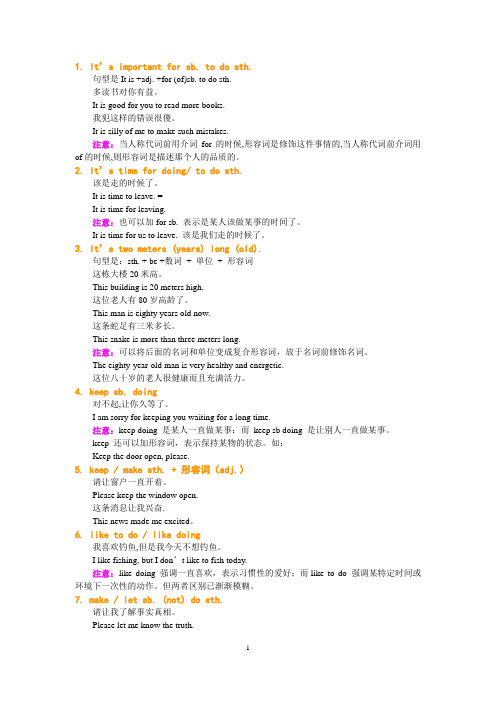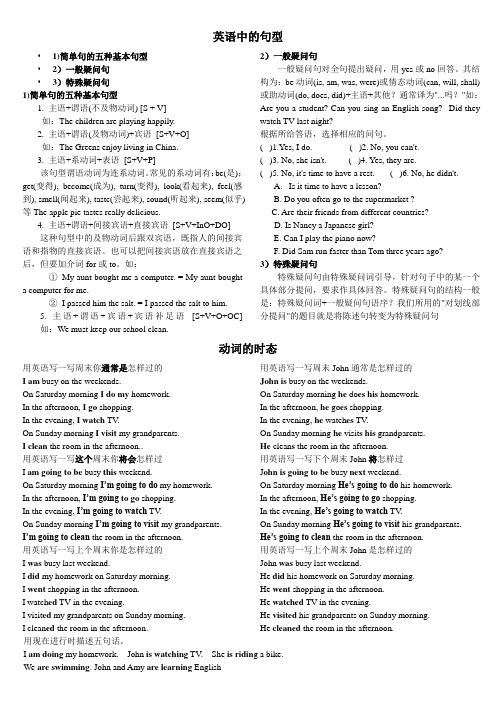中考常见·易错句型12档+57常用句型
中考英语78个易混易错单词+短语+句型(全)

中考英语78个易混易错单词+短语+句型一.英语常用易混淆单词/词组的区别用法how much和how many的区别用法how much和how many的区别:how much用来询问事物的数量,后接不可数名词;how many用来询问事物的数量,后接可数名词复数。
1.所修饰词不同how much用来修饰不可数名词,表示数量,也可单独使用。
how many用来修饰可数名词的复数,它的句式是:How many+复数名词+一般疑问句+?例句:How much milk is there in the glass?玻璃杯里有多少牛奶?How many books are there on the desk?有多少本书在桌子上?2.用法不同How much 表示多少钱,用来问价格。
例句:How much is this dress?这个连衣裙多少钱?How many 表示多少,用来问数量。
例句:How many apples do you have?你有多少苹果?in和on的区别用法:当我们表示某些东西被其他东西所包围时使用“in”这个词。
而“on”用于描述物体被放置在其他物体上方或外部的情况。
in可表时间,表地点,表手段、方法、材料。
on表示时间、地点、方位等。
1.意思不同in:prep.在 ... 里;在 ... 地方;在 ... 期间on:prep.在 ... 之上2.用法不同in:in着重一段时间的过程,常用于重复动作或延续动作。
in表示从现在时间算起推移到将来的一段时间之后,一般与将来时态连用。
He is a layman in economics.他对经济学一窍不通。
on:表示“在物体的表面上”,只能用on的表达方式有on the next morning,on the following。
The spider is walking on the ceiling.蜘蛛在天花板上爬行。
3.侧重点不同in:表示“在其中”。
2024中考英语句型结构知识点五种基本句型结构

2024中考英语句型结构知识点五种基本句型结构
1.主语+谓语:句子最基本的结构,主语表示句子的主体,谓语表示
主语的动作或状态。
例句:I like to read books.
2.主语+谓语+宾语:在主语和谓语之间加上宾语,表示主语的动作的
对象。
例句:She bought a new car.
3.主语+谓语+宾语+宾补:在主语、谓语和宾语之间加上宾补,用来
进一步说明宾语。
例句:They appointed him captain of the team.
4.主语+谓语+表语:在主语和谓语之间加上表语,用来对主语进行补
充说明。
例句:She is a teacher.
5.主语+谓语+宾语+宾语补足语:在主语、谓语、宾语之间加上宾补,用来进一步说明宾语。
例句:They elected him president.。
中考英语必背核心句型(60句)

中考英语必背核心句型(60句)句型1:There+be +主语+地点状语/时间状语There’s a boat in the river.河里有条船。
句型2:What’s wrong with+sb. / sth. ?What’s wrong with your watch?你的手表有什么毛病?句型3:How do you like...?How do you like China?你觉得中国怎么样?句型4:What do you like about...?What do you like about China?你喜欢中国的什么?句型5:had better(not)+动词原形You’d better ask that policeman over there.你最好去问问那边的那个警察。
句型6:How+adj. / adv. +主语+谓语!What a/an+adj. +n. +主语+谓语!How cold it is today !今天多冷啊!What a fine picture it is!多美的一幅图画呀!句型7:Thank+sb. +for (doing) sth.Thank you for coming to see me.感谢你来看我。
句型8:So+be/ 情态动词/ 助动词+主语He is a student. So am I.他是一个学生,我也是。
句型9:... not ... until ...He didn’t have supper until his parents came back.直到他的父母回来他才吃饭。
句型10:比较级+and+比较级The baby cried harder and harder.那孩子哭得越来越厉害。
句型11:the +比较级,the +比较级The more one has,the more one wants.越有越贪。
句型12:... as +adj./ adv.+as ...…not as/so+adj/adv. +as...Do you think that art is as important as music?你认为艺术和音乐一样重要吗?Last Sunday the weather was not so wet as it is today.上个星期天的天气不如今天的天气潮湿。
中考英语总复习 语法点击 十二简单句陈述句、疑问句、反意疑问句、感叹句、祈使句、倒装句

第十四页,共十七页。
考点直击
专题(zhuāntí)(十二) 简单句(陈述句、疑问句、 反意疑问句、感叹句、祈使句、倒装句)
考|点|6 倒装句
1.there be句型 there be 句型是一个典型的倒装句,它表示“某处有某物”,主语 是be动词后面的名词(míng cí)。
她寄给了我一份礼物。
②加for的动词有 buy, make, build, mend, cook等。
My father bought me a bike.=My father bought a bike for me.
我爸爸给我买了一辆自行车。 (5)主语+及物动词+宾语+宾语补足语
The teacher asked the students to listen carefully in class. 老师
考点直击
专题(zhuāntí)(十二) 简单句(陈述句、疑问句、
反意疑问句、感叹句、祈使句、倒装句)
考|点|3 反意(fǎn yì)疑问句
反意(fǎn yì)疑问句的构成: 陈述句+附加疑问句?(附加疑问句 的否定式必须缩写)
1.陈述句部分与附加疑问句部分意思相反: 前肯后否、前否后肯。 M玛a丽ry是is一a名te老ac师he,r, _不__是__吗i_s_n?_'t_s_h?e He didn't tell you the story, __________?
__H__o_w___ fast Jim runs!吉姆跑得多快啊!
第十三页,共十七页。
考点直击
专题(十二(shíèr)) 简单句(陈述句、疑问句、 反意疑问句、感叹句、祈使句、倒装句)
考|点|5 祈使句
中考英语易混易错句型考点归纳

构 的一般 将来时 态是“hr i e 或“ ee s r gigt b ” teeb teewlb ” t r / e o e 。h r e结构有各 种时态 , 以 l h ia n o 可 与各种助 动词和 情态动词 连用 , 是不 能与及 物动词 h v 但 ae连用 。而 “ eeh v&a en 结 构 t r ae s e ” h b 中 的 h v&a 是 助动词 , ae s 这个 结构是 teeb h r e结构 的现在完 成时 态 。)
h r T ee
— — — —
式 。 动词要用 h v, 以填 h v en 助 ae 所 a ebe 。 二、 叹旬 中的 h w 与 w a 感 o h t误用
ห้องสมุดไป่ตู้
引导 感叹句 的 w a 和 hw在 使用时容 易混淆 。w a 通 常修饰 名 词 ,o 通常修饰 形容词 ht o ht hw 或 副词 。例如 :
●H w h ok ! 他工 作多 么努 力啊 1 ( 一句 相 当于 H w h r ew rs 但 不 能写成 : o ew rs f 这 1 o adh ok ! h t e rs W a h ok!因为对 动词感 叹时 , w 要用 hw。) o
【 中考链接】
1 Is x in e s ( .t ct gnw .改为感 叹句) ’e i
●Ho lvr o ! 这 么聪 明的孩 子啊 !) w c e b yi ( e a s ( 这一句 相 当于 Wh t lvr o ei a ac e yh !但不 e b s 能写成 : a l e eb yi! h W t e rh o 因为 hw是 用于对形 容词 或副词 感叹 的。常见 的句型是 : o + cv t s o H w 形容词倡0 主语+ 词+ 谓语 !或: o + H w 主语+ 谓语 !)
中考英语语法易错易混知识点

中考英语语法易错易混知识点一、可数名词与不可数名词1.可数名词表示能够用数目表示的名词,常常可以用单数或复数形式来表示,其前可以加"a"或"an"。
例句:I have a book.(单数)/ I have two books.(复数)2.不可数名词表示不能用数目清楚地表示的名词,只能用单数形式,前面不能加"a"或"an"。
例句:I have some milk.(不可数名词)二、形容词与副词1.形容词修饰名词,用来描述或限定名词。
形容词通常放在名词的前面。
例句:She is a beautiful girl.2.副词用来修饰动词、形容词或其他副词,通常放在被修饰词的后面。
例句:He runs fast.三、一般现在时与现在进行时1.一般现在时表示经常性或习惯性的动作,叙述真理或客观事实。
例句:The sun rises in the east.(真理)/ He often plays soccer on weekends.(习惯性动作)2.现在进行时表示现在正在进行的动作。
例句:I am watching TV now.(正在进行的动作)四、一般过去时与过去进行时1.一般过去时表示已经结束的过去的动作。
例句:I finished my homework yesterday.(过去的动作已经完成)2.过去进行时表示过去其中一时刻正在进行的动作。
例句:They were playing basketball at 7 o'clock yesterday evening.(过去其中一时刻正在进行的动作)五、定冠词与不定冠词1.定冠词"the"用来特指已经提到过或可唯一确定的名词。
例句:I saw the boy in the park.(特指已经提到的男孩)2.不定冠词"a"或"an"用来表示泛指或不特指的名词。
中考英语必备50个句型

1. It’s important for sb. to do sth.句型是It is +adj. +for (of)sb. to do sth.多读书对你有益。
It is good for you to read more books.我犯这样的错误很傻。
It is silly of me to make such mistakes.注意:当人称代词前用介词for的时候,形容词是修饰这件事情的,当人称代词前介词用of的时候,则形容词是描述那个人的品质的。
2. I t’s time for doing/ to do sth.该是走的时候了。
It is time to leave. =It is time for leaving.注意:也可以加for sb. 表示是某人该做某事的时间了。
It is time for us to leave. 该是我们走的时候了。
3. It’s two meters (years) long (old).句型是:sth. + be +数词+ 单位+ 形容词这栋大楼20米高。
This building is 20 meters high.这位老人有80岁高龄了。
This man is eighty years old now.这条蛇足有三米多长。
This snake is more than three meters long.注意:可以将后面的名词和单位变成复合形容词,放于名词前修饰名词。
The eighty-year-old man is very healthy and energetic.这位八十岁的老人很健康而且充满活力。
4. keep sb. doing对不起,让你久等了。
I am sorry for keeping you waiting for a long time.注意:keep doing 是某人一直做某事;而keep sb doing 是让别人一直做某事。
英语中的句型 易错点总结

英语中的句型•1)简单句的五种基本句型•2)一般疑问句•3)特殊疑问句1)简单句的五种基本句型1. 主语+谓语(不及物动词) [S + V]如:The children are playing happily.2. 主语+谓语(及物动词)+宾语[S+V+O]如:The Greens enjoy living in China.3. 主语+系动词+表语[S+V+P]该句型谓语动词为连系动词。
常见的系动词有:be(是);get(变得), become(成为), turn(变得), look(看起来), feel(感到), smell(闻起来), taste(尝起来), sound(听起来), seem(似乎) 等The apple pie tastes really delicious.4. 主语+谓语+间接宾语+直接宾语[S+V+InO+DO]这种句型中的及物动词后跟双宾语,既指人的间接宾语和指物的直接宾语。
也可以把间接宾语放在直接宾语之后,但要加介词for或to。
如:①My aunt bought me a computer. = My aunt boughta computer for me.②I passed him the salt. = I passed the salt to him.5. 主语+谓语+宾语+宾语补足语[S+V+O+OC]如:We must keep our school clean. 2)一般疑问句一般疑问句对全句提出疑问,用yes或no回答。
其结构为:be动词(is, am, was, were)或情态动词(can, will, shall)或助动词(do, does, did)+主语+其他?通常译为"...吗?"如:Are you a student? Can you sing an English song? Did they watch TV last night?根据所给答语,选择相应的问句。
- 1、下载文档前请自行甄别文档内容的完整性,平台不提供额外的编辑、内容补充、找答案等附加服务。
- 2、"仅部分预览"的文档,不可在线预览部分如存在完整性等问题,可反馈申请退款(可完整预览的文档不适用该条件!)。
- 3、如文档侵犯您的权益,请联系客服反馈,我们会尽快为您处理(人工客服工作时间:9:00-18:30)。
句型(一)such+名词性词组+that…So+形容词/副词+that…——如此……以致……例如:(1)She is such a good teacher that we all love her.她是一个好老师,我们都爱她。
(2)It was such a hot day that they didn’t go out for a walk as usual.这么热的天气,他们没有像往常一样去散步。
注意点:1.such+a+形容词+名词+that…,可以改写成:so+形容词+a+名词+that…,例句(1)可以改写成:She is so good a teacher that we all love her.2.在such+形容词+名词复数或不可数名词+that…结构中,形容词如果是many/few或much/little时,用so不用such,即:so+many/few+可数名词复数+that…,so+much/little+不可数名词+that…(1)There are so many people in the room that I can’t get in.房间里人太多,我进不去。
(2)The man has so much money that he can buy a car.那人很有钱,他能买一辆小汽车。
句型(二)There be…,either…or…,neither…nor…,not only…but also…例如:(1)There is a pen and two pencils in his pencil-box.他的铅笔盒里有一支钢笔和两支铅笔。
(2)Not only you but also I have been to the Great Wall.你和我都没有去过长城。
(3)Either you or I am leaving for Shanghai.要么你去上海,要么我去上海。
(4)Neither you nor he is right.你和他都不对。
(5)Both Jack and Tim are English.Jack和Tim是英国人。
注意点:当这几个句型连接主语时,谓语动词的人称和数要考虑“就近原则”,对比both…and… 来记忆,both…and…连接主语时视为复数。
句型(三)Enough+名词+to do…——有足够的……做某事形容词/副词+ enough + to do …——足够……做某事例如:(1)There is enough room to hold these people to have a meeting.有足够的地方容下这些人开会。
(2)The boy is strong enough to carry the heavy box.这个男孩力气够大,能搬动这只箱子。
注意点:只要是enough句型,句子通常可以用so…that…句型,或者too……to……改写。
例(2)改写为:The boy is so strong that he can carry the heavy box.这个男孩力气很大,能搬动这只箱子。
句型(四)too+形容词/副词+to do…——太……以致不能……例如:(1)I was too excited to say a word.我激动得一个字也说不出来。
(2)Tom is too short to reach the apple. Tom太矮了,拿不到那个苹果。
注意点:这是一个否定句型,不能在不定式前加not,可以用so…that…结构改写,例如例句(1)可以改写成:I was so excited that I couldn’t say a word.句型(五)So that …——以便/以致……例如:(1)They studied hard so that they could pass the exam.他们学习很努力,为了能通过考试。
(2)They started early so that they caught the early bus.他们起得很早,结果赶上了早班车。
注意点:在例句(1)中,是引导目的状语;在例句(2)中,是引导结果状语。
一般来讲,so that从句中含有情态动词的,为目的状语。
无情态动词的,为结果状语。
句型(六)祈使句+then/or/and+陈述句例如:(1)Work hard, and/then/and then you will live a happy life.努力工作,你就会过上幸福生活。
(2)Hurry up, or we will be late for school.快点,否则我们上学就迟到了。
注意点:以上句型都可以用条件状语从句来改写。
例句(2)可以改写成:If we don’t hurry up,we’ll be late for school.句型(七)(1)It’s time for sth.是干某事的时间了。
It’s time (for sb) to do sth.该干某事了。
It’s (high) time that sb did sth.该干某事了。
例如:(1) It’s time for the meeting.该开会了。
(2)It’s time for us to go to school.我们该上学了。
(3)It’s high time that you went to bed.你该上床休息了。
注意点:在句型(3)中,可以在time前加rush、high等修饰词,这个句型是虚拟语气的一种,含有“稍迟一点”的含义。
而(2)则是“正是干某事的时候”。
句型(八)(1)It takes sb. Some time to do sth.干某事花某人一些时间(2)sb. spend some time on sth./(in) doing sth.某人花时间在某事上/花时间干某事(3)spend some money on sth./(in) doing sth.花钱在某物上/花钱干某事(4)sth. cost sb. Some money——某事花某人一些钱(5)pay some money for sth.为某事(物)付钱例如:(1)It took me two hours to write the letter.写这封信花了我两小时的时间。
(2)He spends half an hour (in) reading English every morning.他每天早上花半小时读英语。
(3)He spends one hour on the housework every day.他每天花一小时做家务。
(4)The bike cost me 298 yuan.这辆自行车花了我298元。
(5)I spent 298 yuan on the bike.我买这辆自行车花了298 元。
(6)I paid 298 yuan for the bike.我花了298元买这辆自行车。
注意点:cost主语一般为物;spend、pay主语一般为人。
例(1)中it 用做形式主语,动词不定式为真正主语。
句型(九)(1)Why not do…?为什么不干某事?(2)Let’s do …让我们干某事吧。
(3)Shall we do …?我们干某事好吗?(4)Would you like somethin g/to do sth.…?你想要什么吗?你想要干…吗?(5)Will you please do …?请你干某事好吗?(6)What (How) about doing…?干某事怎么样?例如:(1)Why not go and ask our teacher? Good idea! Let’s go.为什么不去问问老师?好主意!走吧!(2)Shall we go out for a walk? No, let’s go to the zoo.我们去散步怎么样?不,我们去动物园吧。
(3)Will you please fetch some chalks for me?请你给我拿些粉笔,好吗?(4)What about singing an English song? Wonderful!唱首英语歌曲怎么样?好极了!注意点:这些句型都是表示“建议”的句子,可视为同义句。
句型(十)(1)Let’s go out for a walk, shall we? 让我们出去散步,好吗?(2)Read the book carefully, will you? 认真读书,好吗?注意点:在这两个句型中,(2)所代表的祈使句,一般用will you构成反意疑问句。
在(1)中Let’s表示包括“我”在内,用shall we,但若是let us,表示不包括“我”在内,则用will you。
例如:Let us go out for a walk, will you? 你让我们出去散散步,好吗?句型(十一)So + be/助动词/情态动词+主语——也……Neither/Nor + be/助动词/情态动词+主语——也不……例如:(1)He can sing a lot of English songs, so can she.他会唱很多英语歌曲,她也是。
(2)She speaks English very well, so do I.她英语说得好,我也是。
(3)Li Lei hasn’t read this book, neither has Lin Feng. 李蕾没看过这本书,林风也没看过。
注意点:这两个句型都表示和前面所陈述的内容相同,用倒装句。
要注意和“so+主语+be/助动词/情态动词——确实是”相区别,试对比一下例(2):A:She speaks English very well.她英语说得很好。
B:so she does.确实是这样。
句型(十二)I don’t think his answer is right.我认为他的答案不对。
例如:(1)I can’t believe she is right.我相信她是不对的。
(2)You don’t think they will come tomorrow, do you?你认为他们明天不会来,是吗?注意点:Think、believe、suppose 等接宾语从句时,变为反意疑问句时,若主语是第一人称,反意从句,若主句主语是其他人称,反意主句。
例(1)变为反意疑问句应为:I can’t believe she is right, is she?57个中考必备句型1 as soon as2 as…as3 as…as possible4 ask sb. for sth.5 ask/tell sb. (how) to do sth.6 ask/tell sb. (not) to do sth.7 be afraid of doing/that8 be busy doing sth.9 be famous/late/ready/sorry for…10 be glad that11 buy/give/show/bring/lend/send/pass/tell…sth. to sb.12 buy/give/show/bring/lend/send/pass/tell sb. sth.13 either…or14 enjoy/hate/like/finish/stop/mind/keep/go on doing sth.15 find it + adj to do sth.16 get + 比较级17 get ready for/get sth. ready18 had better (not) do sth.19 help sb. (to) do/help sb.with20 I don’t think that21 I would like to /Would you like to…?22 is one of the + 最高级+ n(pl.)…23 It is +adj. for sb. to do sth.24 It is a good idea to do sth.25 It is the second + 最高级+n.26 It looks like …/It sounds like …27 It seems to sb. that…28 It sounds +adj. /It looks +adj.29 It takes sb some time. to do sth.30 It’s bad/good for…31 It’s time for…/to do sth.32 It’s two meters (years) long (high, old).33 keep sb. doing34 keep/make sth. +adj.35 like to do / like doing36 make / let sb.(not) do sth.37 neither…nor38 not…at all39 not…until40 One…the other…/Some… others…41 prefer…to42 see/hear sb. do(doing) sth.43 so…that44 spend…on /(in) doing sth.45 stop to do /stop doing46 such a +adj. +n. that…47 take/bring sth with sb.48 thank sb for sth.49 The more…the better50 There is sth. wrong with…51 too…to52 used to53 What about /How about…?54 What’s the matter with…?55 What’s wrong…?56 Why not…?57 Will (would, could) you please…?。
